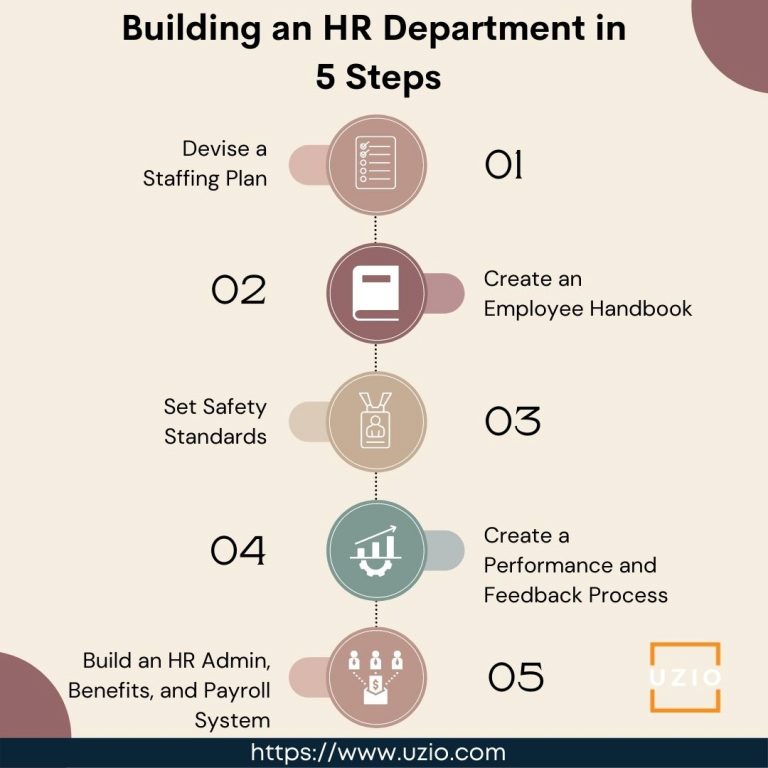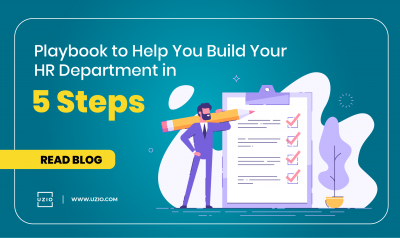Today’s most successful businesses thrive by having a strong, cohesive HR (human resources) department.
Without an efficient HR team, it’s hard to imagine running a successful operation. Since an effective HR department is so crucial to the success of a business, even small and medium-sized businesses (SMBs) aspire to establish an HR department.
Sometimes referred to as a people department, the men and women of HR are responsible for overseeing company culture, hiring, employee onboarding, time tracking, employee engagement, payroll, benefits, and workers’ compensation.
A solid HR department takes a load off the business owner, allowing them to focus on more important tasks instead.
Of course, an HR department is policy and process-driven.
Building An HR Department in 5 Steps
If you’ve never set one up before it may seem confusing, so here’s a list of 5 steps to assist you with forming a successful HR department for your business.

1. Devise a Staffing Plan
Staffing requires a strategic, data-driven approach if you want to be successful.
It doesn’t start and end with recruiting the right people. Staffing is an on-going task that includes evaluating organizational needs, growth strategy, and a full spectrum of both skills & resources.
All of this must align with the company-wide business goals to ensure business success. A proper staffing plan helps businesses:
- Improve the recruitment process
- Increase employee retention
- Optimize the promotion process
Here’s a Mini-Plan for Building A Staffing Plan
- Set measurable goals for optimizing staffing and employee development levels. This means:
- Deciding which HR metrics to track
- Implementing a way to analyze progress
- Evaluate your current staff. Here’s what you need to look at,
- The existing in-house skillset
- Employee performance levels
- Top-performing employees
- Current compensation rates vs. the industry average
- Predict the optimal staffing levels using:
- Trend analysis
- Industry benchmarks analysis
- Conduct a gap analysis. This will let you:
- Prepare to let go surplus employees and resources
- Analyze current and previous shift management data
2. Create an Employee Handbook
Though we may not always agree with them, rules are there for a reason: they promote unity and growth through a unified code of conduct.
These are the main reasons why you should create a crystal-clear code of employee conduct.
A good employee handbook covers safety, health, and company culture in an easy-to-read digital or print form.
If possible, you should have both a hard and a soft copy available, so employees never have the excuse of “I lost it”.
It’s important to include answers to any current questions (or questions commonly asked by new employees) in a FAQ section as well.
By providing employees with a specific book of instructions and guidelines, you will be standardizing conduct and optimizing your business from the start.
3. Set Safety Standards
These standards cover physical, verbal, and virtual practices.
It’s important to provide employees a clean, hygienic, and safe workplace where they can comfortably spend their 8-10 hour days.
Ensure that these guidelines are strictly adhered to so that no employee is ever in physical danger.
Beyond physical standards, verbal and virtual standards are important as well.
A sexual harassment policy is a must and needs to be readily accessible by any employee.
These policies cover verbal and virtual conduct both inside the workplace and out.
Another important thing? Having an EAP (Emergency Action Plan).
If something goes wrong, employees need to have a response plan in place, especially if evacuation is necessary.
4. Create a Performance and Feedback Process
It’s hard to recognize progress if you have no method in place of measuring it.
Performance expectations provide measurable goals and metrics to monitor both employee and business progress.
A comprehensive performance management and feedback process play a critical role in attracting and retaining key employees.
By monitoring and measuring progress, you ensure employees reach their full potential while confirming they’re happy with their roles and growth within the team.
5. Build an HR Administration, Benefits, and Payroll System
The success of your HR department will ultimately depend on the approach you choose, so go with one that’s adaptable and expandable.
An all-in-one, fully integrated HR, benefits, payroll, and workers’ compensation platform for e.g. UZIO automates your people management workflows and helps you to:
- Eliminate manual tasks while increasing productivity
- Efficiently handle tedious and time-consuming HR administrative tasks
- Ensure 100% payroll accuracy
- Offer a wide range of benefits to your employees
- Quickly address all workers’ compensation claims and policies
The Conclusion...
Having an excellent HR team is essential if you want your business to grow, expand, and prosper.
Without a productive HR team, your employee relations, hiring, training, career development, benefits, and company culture will all suffer!
Of course, now you know how to create your HR department within your company, so take these tips, choose a team size, and start building your HR team today!















